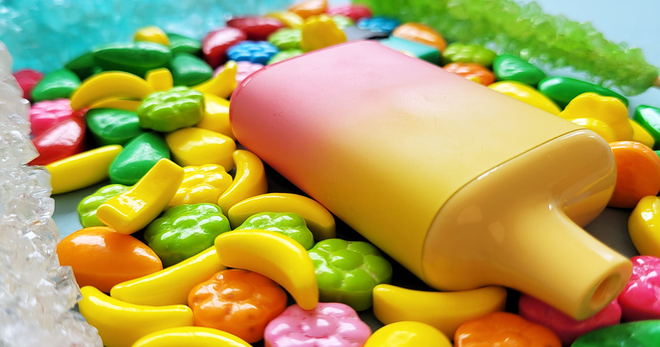New federal data: flavored e-cigarettes continue to drive youth vaping epidemic, with disposable use up 1,000% among high schoolers
New federal data show youth vaping has declined, but remains at epidemic levels in the absence of comprehensive e-cigarette regulation. Disposable and menthol-flavored e-cigarettes -- two product types exempted from federal restrictions -- rapidly gained nearly three-quarters of the e-cigarette market and disposable use among high school students increased 1,000% over last year.
1000%
Disposable use among high school students increased 1,000% over last year
52%
Menthol-flavored e-cigarettes accounted for more than half of total e-cig sales
72.6%
72.6% of disposable sales were for flavors banned for pod-based products
Released on the deadline for e-cigarette makers to submit applications to the Food and Drug Administration to keep their products on the market, the 2020 National Youth Tobacco Survey finds that one in five high school students (19.6%) and one in 20 middle school students (4.7%) reported being a current e-cigarette user. The 2020 data, which were only collected for a portion of the school year due to the coronavirus pandemic, mark a drop in youth e-cigarette use from 2019, when 27.5% of high school students and 10.5% of middle school students reported current e-cigarette use.
Many young people reported that they are vaping every day or nearly daily, underscoring the highly addictive nature of nicotine. Among current e-cigarette users, 38.9% of high school students and 20% of middle school students reported using e-cigarettes on 20 or more days in the past month, and 22.5% of high school users and 9.4% of middle school users reported daily use.
A separate analysis of e-cigarette unit sales data released alongside the survey demonstrates dramatic shifts in the e-cigarette market, as users switch to products that remain available due to loopholes in federal policy enacted in February. The study by Truth Initiative, the Centers for Disease Control and Prevention and CDC Foundation shows that by May 2020, menthol-flavored e-cigarettes accounted for more than half (52%) of total e-cigarette sales, and among all disposable e-cigarette sales, menthol flavored e-cigarettes accounted for 10% of the market. Previously, these products made up a small slice of an e-cigarette landscape dominated by JUUL and its popular flavors like fruit medley, mango, and mint that fueled the youth vaping epidemic. In fact, menthol e-cigarettes and disposable products each accounted for only about one-tenth of e-cigarette sales a year ago in August 2019.
8 in 10 young users vape flavored e-cigarettes
Flavored e-cigarettes continue to drive the crisis with more than eight in 10 young users (82.9%) reporting they use flavored e-cigarettes, according to the 2020 survey. While pre-filled pods or cartridges like JUUL remain the most popular device type, use of disposable e-cigarettes like Puff Bar increased about 1,000% (from 2.4% to 26.5%) among high school e-cigarette users and more than 400% (from 3% to 15.2%) among middle school e-cigarette users.
The increase in disposable use follows recent federal policy on flavored e-cigarettes that went into effect in February 2020 and contained a major exemption for disposable flavored e-cigarettes. Far from a total ban on flavored e-cigarettes the president proposed a year ago, the FDA policy allows menthol to remain on the market in all forms and only limits fruit and candy flavors for pre-filled, closed-system e-cigarettes, like JUUL. That means disposable and open-system, refillable devices still offer a variety of kid-friendly flavors, including cotton candy, sour apple and O.M.G. (orange, mango, guava), among many others.
Some products thrive in absence of regulation
Disposable and menthol-flavored e-cigarettes -- both exempted from federal restrictions – have rapidly taken over most of the e-cigarette market.
Between August 2019 and May 2020, during which JUUL suspended in-store sales of some fruity and sweet flavors before the partial federal guidance took effect in February, menthol sales shot up from 11% to 52% of total e-cigarette sales, effectively replacing mint. Mint, which was previously one of the favorite flavors reported by youth and young adults according to Truth Initiative surveys, had accounted for 43% of total e-cigarette sales in August 2019.
At the same time menthol was gaining market share, disposable e-cigarettes like Puff bar – a JUUL copycat that has gained rapid popularity– almost doubled from 10.3% to 19.8% of the market. Underscoring the impact of loopholes that leave many flavors on the market, flavors that are no longer available for JUUL and other pod-based products account for the majority of disposable sales. By May 2020, nearly three-quarters – 72.6% -- of disposable sales were for flavors banned for pod-based products, including mint and other non-tobacco, non-menthol flavors.
An opportunity to stop the epidemic
September 9 marked the deadline for e-cigarette makers to submit applications to the FDA to keep their products on the market. Now, four years after e-cigarettes came under FDA oversight, manufacturers must finally obtain the agency’s authorization to continue selling these products.
“The decline in youth e-cigarette use is good news but the deeper story is quite troubling. We still have millions of kids vaping and at risk of addiction and becoming tobacco consumers for life. These reports make clear that unless stronger federal policies are put in place immediately—policies that are free of the loopholes that allowed for menthol and flavored disposable sales to soar—this progress is at risk of being reversed or significantly slowed,” said Robin Koval, CEO and President of Truth Initiative.
To gain FDA authorization to market a new tobacco product, federal law requires manufacturers to demonstrate that the product is “appropriate for the protection of the public health.” As the agency reviews these products, it must act quickly to remove flavored e-cigarettes that put a generation at risk of nicotine addiction.
More in emerging tobacco products
Want support quitting? Join EX Program
By clicking JOIN, you agree to the Terms, Text Message Terms and Privacy Policy.
Msg&Data rates may apply; msgs are automated.



